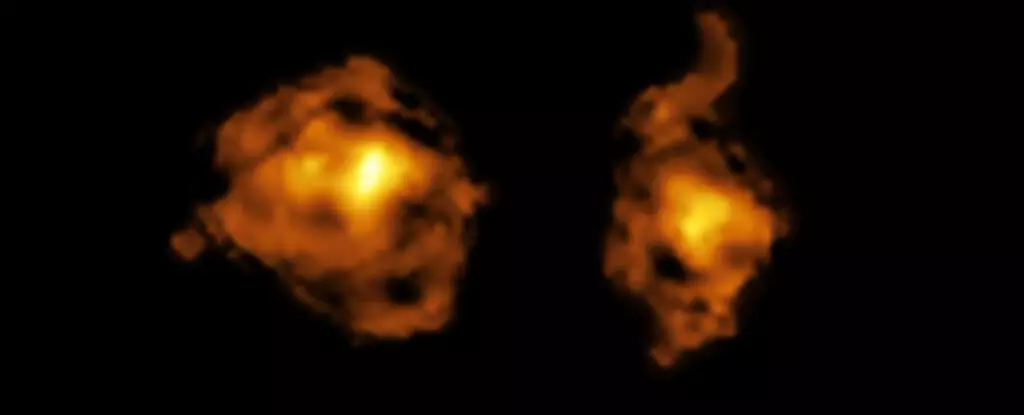In the boundless cosmos, the interaction of galaxies showcases a stunning level of dynamism, rivaling even the most intricate terrestrial ecosystems. Recent findings have illuminated an unparalleled event: a galaxy being afflicted by the intense radiation emitted from another galaxy’s supermassive black hole during a spectacular collision. Dubbed the ‘cosmic joust,’ this phenomenon is not just an astronomical curiosity; it signifies a profound interplay between galaxies that reshapes their structures and influences star formation on a grand scale. By witnessing such an event, researchers have unearthed new layers of complexity regarding the evolution of cosmic entities.
This encounter futher highlights a vibrant truth: our universe is interlinked not merely by the apparent movements of galaxies but by the unseen, powerful force of dark matter that orchestrates their clustering and collisions. These interactions aren’t random incidents; they are monumental events that can dictate the future of entire galaxies and the immense black holes that occupy their cores. Through millions of years, galaxies spiral together drawn by their mutual gravitational forces, often culminating in collisions that could lead to new formations or the destruction of existing stars. Yet, this cosmic dance offers more than mere destruction—it holds the promise of rebirth.
Quasars: The Cosmic Powerhouses
At the heart of the cosmic joust lies a particularly captivating player: the quasar. This incredibly bright object is essentially a galaxy with a supermassive black hole at its center that is actively feeding on surrounding material. The process is nothing short of cataclysmic, generating unfathomable amounts of energy as matter spirals into the abyss. In this scenario, the energy isn’t merely a byproduct but a pivotal influence that alters the entire trajectory of the other colliding galaxy. As the quasar barrels through space at staggering speeds, its radiation engulfs the neighboring galaxy, disrupting its ability to form new stars.
The ramifications are dire yet fascinating. Star formation is essentially halted in the ‘injured’ galaxy, as the radiation clears away the dense gas and dust crucial for igniting new stellar life. This interaction elucidates a remarkable characteristic of our universe: creation often follows destruction. The galactic joust serves as a compelling reminder that even amidst chaos, new beginnings can emerge, albeit in an unexpected form.
Supermassive Black Holes: The Dual Nature of Creation and Destruction
Interestingly, both colliding galaxies endure trials. The quasar’s appetite extends far beyond its own galaxy, gravitationally siphoning off gas from its interstellar neighbor. This robbing of resources not only fuels the quasar’s insatiable hunger, but also exacerbates the galactic starvation in the wounded galaxy. Meanwhile, as the quasar devours material, it simultaneously unleashes powerful outflows that push away any potential star-forming gas within its own boundaries. This quenching effect is disruptive, illustrating a vicious cycle where one galaxy’s growth comes at the expense of another’s sustenance.
However, the cosmic joust also lays the groundwork for potential rejuvenation. When these massive gas clouds collide, they generate shockwaves and gravitational disturbances that can trigger new star formation in regions of high density. This phenomenon portrays an extraordinary aspect of the universe’s design: the ability to regenerate and transform, even in the wake of catastrophic events. Through these galactic encounters, the universe continues to evolve, adapt, and flourish.
A New Era of Cosmic Understanding
The implications of such findings stretch far beyond mere astronomy; they alter our perception of cosmic evolution itself. Understanding the intricate relationships and consequences of these galactic collisons allows astronomers to glean insights into the lifecycle of galaxies—all intertwined in a vast cosmic narrative that unfolds over billions of years. The ‘cosmic joust’ stands as a powerful testament to the dynamic processes that shape not just individual galaxies, but also the very structure of the universe we inhabit.
This extraordinary discovery compels us to rethink our understanding of galactic dynamics. With each new finding, we are reminded that the universe is a theater of continual transformation, where cataclysmic events are often the prelude to vibrant new beginnings. As we stand on the precipice of further astronomical investigations, the cosmic joust offers both a spectacle of power and a glimpse into a deeper, interconnected reality—a reminder that creation and destruction are but two sides of the same cosmological coin.

